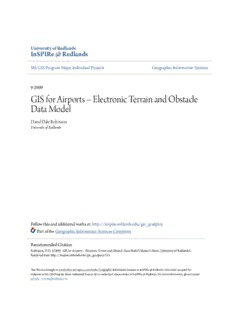
GIS for Airports PDF
Preview GIS for Airports
University of Redlands InSPIRe @ Redlands MS GIS Program Major Individual Projects Geographic Information Systems 9-2009 GIS for Airports – Electronic Terrain and Obstacle Data Model David Dale Robinson University of Redlands Follow this and additional works at:https://inspire.redlands.edu/gis_gradproj Part of theGeographic Information Sciences Commons Recommended Citation Robinson, D. D. (2009).GIS for Airports – Electronic Terrain and Obstacle Data Model(Master's thesis, University of Redlands). Retrieved from https://inspire.redlands.edu/gis_gradproj/135 This material may be protected by copyright law (Title 17 U.S. Code). This Thesis is brought to you for free and open access by the Geographic Information Systems at InSPIRe @ Redlands. It has been accepted for inclusion in MS GIS Program Major Individual Projects by an authorized administrator of InSPIRe @ Redlands. For more information, please contact [email protected]. University of Redlands GIS for Airports – Electronic Terrain and Obstacle Data Model A Major Individual Project submitted in partial satisfaction of the requirements for the degree of Master of Science in Geographic Information Systems by David Dale Robinson Douglas Flewelling, Ph.D., Committee Chair Ruijin Ma, Ph.D. September 2009 GIS for Airports – Electronic Terrain and Obstacle Data Model Copyright © 2009 by David Dale Robinson The report of David Dale Robinson is approved. September 2009 Acknowledgements Accomplishing this project would have been impossible without the help and encouragement of many people. I must begin by acknowledging my dear partner, Allen Omoto, without whom none of this would have been possible. He persuaded me to take a chance on a new career path and pursue this MS GIS degree. He helped me with statistics, helped edit papers and PowerPoint presentations, and gently prodded me to get things done. He put up with chaos at home, and patiently listened to “I’ll get to it sometime” all year long. Thanks Allen, I promise this was all worthwhile! I would also like to thank the rest of my family, and all my friends, for holding me up throughout the year. How can people endure so much complaining? I also want to thank my primary contact at ESRI, Shane Barrett, Aeronautical Solution Product Manager. Shane was instrumental in shaping the scope and extent of this project, proving to be very flexible and accommodating to changes along the way. He was very accessible throughout the project, even providing me an office in which to work at the ESRI campus. His patience and perseverance as I struggled with aeronautical data and SDE databases will forever be appreciated. Next, I want to express my gratitude to my project committee: Ruijin Ma, Ph.D., and Douglas Flewelling, Ph.D. (Committee Chair). Thanks to Ruijin Ma, for his enthusiastic interest in my project early on, and his thoughtful comments and edits of this document. And a special thanks to my chair, Douglas Flewelling who kept me focused and on scope all along the way. His beneficial repetition of the mantra “…the best MIP is the completed MIP” single handedly is the reason this document was finished. With good humor and respect for my best judgment, he pressed me along to complete the project in time for my scheduled defense. This program would not function without the steadfast support of the MS GIS staff and faculty. Thanks to the staff at the Research Institute and all our ESRI instructors. A special thanks to Debra Riley, Program Coordinator, for her special qualities of patience, organization, and friendship to all the frenzied students of Cohort 14. A special thanks to due Dorothy Watkins, my friend in Cohort 14, whose help with Model Builder provided a breakthrough in creating a better selection process in my project. And finally, it is with a sad heart that I say goodbye to my colleagues in Cohort 14. From a seemingly disparate group of individuals, we coalesced into a band of friends who championed one another through a year of struggles and triumphs. I dare say I will never again experience the kind of camaraderie and closeness we had with Cohort 14. I will cherish the times I spent with you in Lewis 104. Thanks for a very, very special year. v Abstract GIS for Airports – Electronic Terrain and Obstacle Data Model by David Dale Robinson This project presents a custom GIS solution to aid in the production of electronic terrain and obstacle data sets (eTOD) for the world’s airports. The eTOD mandates underlie the International Civil Aviation Organization’s (ICAO) effort to modernize world air traffic control. ICAO has set a deadline of November, 2010 for nations to assemble eTOD sets for all their airports. The project client, ESRI, sought a custom eTOD solution for users, with limited GIS experience, to assess the quality of their terrain and obstacle data and plan for further data acquisition. A file geodatabase was developed to organize the user’s existing aeronautical data and manage these data for project application use. The eTOD rules establish data quality standards for four Coverage Area designations, each represented by specifically shaped and sized boundaries around airports. Methods were developed to generate these boundaries using tools assembled with ArcGIS Model Builder in ArcView. The models simultaneously select the obstacles within the generated boundaries for data quality assessment. With limited training, a user can easily organize their data, automatically generate the eTOD Coverage Areas, and produce data quality assessment reports in support of their preliminary efforts towards reaching eTOD compliance. vii
Description: